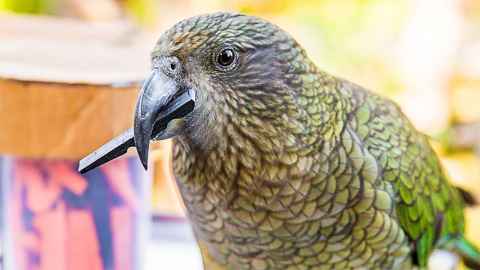Smarter than we thought: Kea reason about probability
4 March 2020
Kea make smart predictions when reasoning about uncertain events, behaving similarly to humans when faced with statistical reasoning tasks, according to a new study from the School of Psychology.

Publishing in Nature Communications, PhD candidate Amalia Bastos and Associate Professor Alex Taylor carried out an experiment to test New Zealand’s alpine parrots (Nestor notabilis) on their ability to make predictions using statistical, physical and social information in a similar way to a human.
In the three-part study, six kea from Willowbank Wildlife Reserve near Christchurch were first shown that choosing a black-coloured token always led to a food reward, while an orange-coloured token never did.
They were then shown two jars of mixed tokens, one with more black tokens than orange and one with more orange than black. A human experimenter then reached into each jar and brought out a token hidden in their fist so the birds could not see what colour it was.
Kea then had to predict which hand they thought held the prized black token. The birds consistently chose the hand that had reached into the jar with the greatest number of black tokens, showing they could use the relative frequency of black and orange tokens to make a prediction.
The experimenters then tested if kea could combine other sources of knowledge into their predictions about uncertain events. The birds were presented with two jars of tokens with a barrier positioned across the middle between top and bottom so that only the tokens at the top were accessible. Even though both jars had an equal number of black and orange tokens in total, kea consistently chose from the jar that had a greater number of black tokens in the accessible top half of the jar.
This part of the study showed the birds were able to combine information about the physical world (in this case the presence of a barrier in the middle of the jar) with information about the relative frequency of tokens, an ability that has so far only been demonstrated in human infants.
Lastly, kea were tested on their ability to incorporate social information into their predictions. Two experimenters each took tokens from separate jars, but one of the experimenters showed a bias: she always took a black token from her jar even though there were many more orange than black tokens in the jar. The other experimenter took a token without looking, from a jar with many more black tokens than orange, and so also ended up with black tokens, but only because there were more of these in the jar.
When kea then observed both experimenters taking tokens from jars with the same amount of tokens, they consistently chose the fist offered by the biased experimenter. To date, only humans and chimpanzees have been shown to integrate social and frequency information in this way.
“The results from the study are surprising as they mirror those from infants and chimpanzees in similar tests,” Ms Bastos says.
“They show kea can look at the ratio of objects to make a prediction about uncertain events – what we call statistical inference. That kea could then integrate different types of information into these predictions was really unexpected: this type of integration has been thought to require language.
"This is the first evidence that a bird can make true statistical inferences and integrate different types of information into their predictions of uncertain events.”
Associate Professor Taylor says one of the fascinating aspects of the study is its implications not only for biological intelligence but also potentially for artificial intelligence.
“One of the holy grails of research on artificial intelligence is the type of common-sense reasoning that humans show, where we bring together multiple sources of information into a single prediction or judgement about what will happen next in the world,” he says.
“Our work suggests that aspects of this ability have likely evolved twice on our planet, in primates and birds.
"It also suggests that, for AI researchers looking to biological intelligence for inspiration, it might be useful to complement the current focus on the mammalian brain with work on the very different avian brain as well.
"Understanding what processes are shared between these two types of brain when faced with these types of tasks could help us understand how to create AI capable of making more domain-general, common-sense judgements.”
Media contact
Anne Beston | Media adviser
DDI 09 923 3258
Mob 021 970 089
Email a.beston@auckland.ac.nz